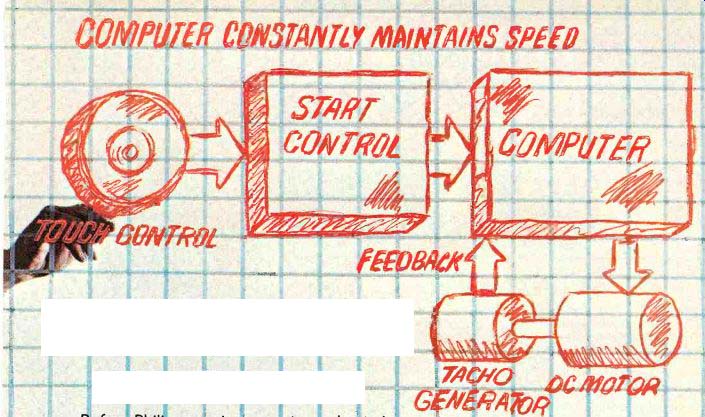

THE ELECTRONIC TURNTABLE.
An electronic computer controls the speed; electronic circuits control everything else.
Electronic devices are more accurate and more reliable than even the most sophisticated mechanical device.
But you know that. What you may not know is that now the precision of electronics has been put to work in a turntable in ways electronics have never been used before.
The Philips GA 212 Electronic Turntable. More than mechanical. Less than $170.
The turntable is the Philips GA 212 Electronic. It gets its go from a low-rpm, servo-controlled d.c. motor, much the way the best (read: expensive) turntables do. But then the GA 212 goes the best one better.
A computer to control the servo-control.
To ensure constant, accurate speed, the GA 212 regulates its motor with a mini-computer. The computer corrects even the slightest variations in speed at the speed of light. Electronically.
Wow, flutter and drift are so low as to be virtually undetectable; cartridge tracking forces, stylus/groove friction, cleaning-brush drag and line-voltage fluctuations leave the GA 212's precise speed unaffected.
*Optional with dealer.
COMPUTER CONSTANTLY MAINTAINS SPEED
However, if you want to alter pitch, a strobe ring and two potentiometers put electronic control at your fingertips.
Electronic speed-switching to eliminate vibrations.
Before Philips, starting, stopping and switching turntable speed from 33 to 45 rpm, were all-- done mechanically. The GA 212 controls al i three functions electronically.
You don't push the GA 212's buttons (and maybe give the stylus the shakes), you merely touch them, 'feather-lightly. No mechanical pres sure, no vibrations.
To further immunize this remarkable turn table against mechanical and acoustic feedback, Philips engineers float the platter and tonearm on a cushioned subchassis, while rigidly mounting the motor to the main chassis. Only a shock absorbing belt connects platter and motor. The precision-ground belt also reduces rumble to inaudibility.
Photo-electronic shut-off stops stutters before they start.
Even to shut off the motor at the end of a record, Philips has replaced mechanics with electronics. Or, rather, with electronics and optics. For the GA 212 shuts itself off-simply and silently-by interrupting a light beam with a hidden lever that parallels the tonearm.
The tonearm, not so incidentally, is a fitting and flawless companion for the turntable. In engineering the arm, Philips eschewed seductive curves and played it straight. Because straight is the shortest (least mass, distance between two points. And less mass means less resonance.
Of course, the arm's geometry, adjustments and controls are as advanced as the motor's controls. And you know how advanced those are.
PHILIPS HIGH-FIDELITY LABORATORIES
For the name and address of your nearest franchised Philips deafer, call 800-243-6100, day or night, toll-free. (In Conn.: 1-800-882-6500.)
++++++++++++++++++
Also see:
AUDIO BASICS: The Greater Good
TIME-LIFE RECORDS--The Definitive Beethoven Collection
Source: Stereo Review (USA magazine)